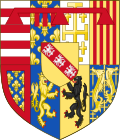
This is a list of the counts of Eu , a French county in the Middle Ages (Eu is in the department of Seine-Maritime, in the extreme north of Normandy), disputed between France and England during parts of the Hundred Years' War.

This is a list of the counts of Eu , a French county in the Middle Ages (Eu is in the department of Seine-Maritime, in the extreme north of Normandy), disputed between France and England during parts of the Hundred Years' War.



Raoul IV was accused of treason in 1350, and the county was confiscated. The county was then given to John of Artois.






In 1660, he sold Eu to the Duchess of Montpensier.
She sold it in 1681 to the Duke of Maine.
The title was used by the House of Bourbon du Maine till 1775 when that house became extinct. It then passed over to the cousins of the du Maines: The House of Bourbon-Penthièvre